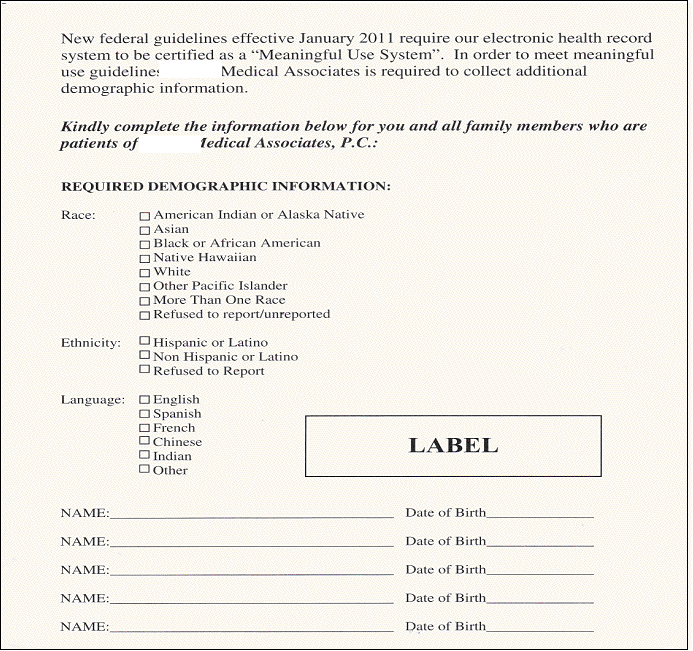Data Collection Form Design Issues
Summary: So, what can the American Recovery and Reinvestment Act (ARRA) of 2009 — also known as Stimulus 1 — teach us about survey questionnaire design practices? You may think nothing, but you’d be wrong. We can see the need for thinking through the logic of the data collection form and the introduction for a form that is all about demographic data.
~ ~ ~
On a recent visit to my doctors office I was told I needed to complete the form shown nearby. We’re all used to getting a new form to sign seemingly on every visit to every doctor’s office to meet some new regulation that’s been dreamed up, but this one was different.
So here’s a quiz. What a “Meaningful Use System”?
If you know then, 1) you work in some facet of the health care delivery network, 2) you work in the Department of Health & Human Services, or 3) you’re a pitiful wonk who needs a life. I had to do quite some online digging to figure it out. As I learned on the HHS site, “The HITECH portion of the American Recovery and Reinvestment Act (ARRA) of 2009 specifically mandated that incentives should be given to Medicare and Medicaid providers not for EHR adoption but for ‘meaningful use’ of EHRs.” [For you non-wonks, EHR stands for Electronic Health Record. Unfortunately, the link to that description is now gone.]
Got that?
So the introduction to this data collection form entices me to provide the information by stating:
New federal guidelines effective January 2011 require our electronic health record system to be certified as a “Meaningful Use System”. In order to meet meaningful use guidelines, XXX Medical Associates is required to collect additional demographic information.
In surveys I design I always soften the requests for demographic information since most people value their privacy and are hesitant to provide personal information without good cause. Does the introduction here inspire me to want to complete the data collection form? Heck no. Then, rather than have a “Prefer Not to Say” option, instead if I want to protect my privacy, I am labeled as “Refused to report.”

Then I am asked to “kindly complete the information below for you and all family members…” The “Required Demographic Information” is Race, Ethnicity, and Language. Some of you will disagree with me here, but I am one of those who resents being asked these questions. I believe in a society based on merit where superficial characteristics are irrelevant. Even worse, I resent being told I must provide the information. Should I choose not to provide it, I have to check “Refused to Report.” I am a marked man. One can imagine a phone call for such a choice!
Also, look at the logical disconnect in the form. I have to report this information for all my family members, who are to be identified at the bottom of the form, but there’s only one set of check boxes. The structure of the form presumes a homogeneous household! This is America. We have many households of mixed race, ethnicity, and language. What to do if you have a heterogeneous household?
Note also there are no instructions such as “check all that apply” or “check only one.” By convention with checkboxes — as opposed to radio button, I should check all that apply.
Let’s accept that there’s a good reason for this information beyond some bureaucratic carrot and stick. So, how does this information enhance this medical group’s EHRs to become a “meaningful use system? We could conjecture on this. Perhaps epidemiological studies will examine statistical associations between medical conditions and demographic profiles.
But if that were true, then explain the degree of specificity requested, especially for ethnicity, which sees Americans as Hispanic/Latino — and everyone else. Wow. That is a truly bizarre way of segmenting America’s ethnicity. We have great specificity for some races that are single-digit percentages but the majority of Americans will fall in one lump. It’s hard to see how the data here would be used for data analysis for medical research. Occam’s Razor says it’s use is for diversity assessment.
I was told that the form was a creation of the federal government. I don’t know if that’s true, but I wouldn’t be surprised. I am one of those who is not thrilled at the prospect of the inevitable barrage of unintended consequences from the Patient Protection and Affordable Care Act (PPACA)and ARRA. If this small window into the acts is any indication, I am even less thrilled. But at least we learned something about survey design and data collection form design.
